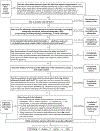Explaining Sudden Unexpected Infant Deaths, 2011-2017
- PMID: 33906930
- PMCID: PMC8132195
- DOI: 10.1542/peds.2020-035873
Explaining Sudden Unexpected Infant Deaths, 2011-2017
Abstract
Background: Sudden unexpected infant death (SUID) represents a broad group of explained and unexplained infant deaths (<1 year old). Explaining why SUID occurs is critical to understanding etiology and prevention. Death certificate data cannot differentiate explained from unexplained SUID cases nor describe the surrounding circumstances. We report SUID rates by explained and unexplained categories and describe demographics and history of recent injury or illness using the Centers for Disease Control and Prevention SUID Case Registry.
Methods: The registry is a population-based surveillance system built on Child Death Review programs. Data are derived from multiple sources, including death certificates, scene investigations, and autopsy reports. Cases included SUIDs reported by states or jurisdictions participating in the registry during 2011-2017. Cases were classified into explained and unexplained categories by using the registry's classification system. Frequencies, percentages, and mortality rates per 100 000 live births were calculated.
Results: Of the 4929 SUID cases, 82% were categorized as unexplained. Among all cases, 73% had complete case information. Most SUIDs (72%) occurred in an unsafe sleep environment. The SUID mortality rate was 97.3 per 100 000 live births. Among explained and possible suffocation deaths, ∼75% resulted from airway obstruction attributed to soft bedding.
Conclusions: Unsafe sleep factors were common in explained and unexplained SUID cases, but deaths could only be classified as explained suffocation for ∼20% of cases. Further analysis of unexplained deaths, including continued improvements to death scene investigation and documentation, may generate hypotheses for physiologic and genetic research, advance our understanding of gaps in SUID investigation, and enhance our understanding of infants at highest risk.
Keywords: CDC; CDR; Centers for Disease Control and Prevention; Child Death Review; DSI; NAME Panel; NFR-CRS; National Association of Medical Examiners’ Panel on Sudden Unexpected Death in Pediatrics; National Fatality Review Case Reporting System; SIDS; SUID; death scene investigation; sudden infant death syndrome; sudden unexpected infant death.
Copyright © 2021 by the American Academy of Pediatrics.
Conflict of interest statement
POTENTIAL CONFLICT OF INTEREST: The authors have indicated they have no potential conflicts of interest to disclose.
Figures


Comment in
-
The Call to Translate Data Into Action to Prevent Infant Death.Pediatrics. 2021 May;147(5):e2020042135. doi: 10.1542/peds.2020-042135. Pediatrics. 2021. PMID: 33906931 No abstract available.
Similar articles
-
Classification system for the Sudden Unexpected Infant Death Case Registry and its application.Pediatrics. 2014 Jul;134(1):e210-9. doi: 10.1542/peds.2014-0180. Epub 2014 Jun 9. Pediatrics. 2014. PMID: 24913798 Free PMC article.
-
Unexplained Infant Deaths Without Unsafe Sleep Factors: 2011 to 2020.Pediatrics. 2024 Nov 1;154(Suppl 3):e2024067043G. doi: 10.1542/peds.2024-067043G. Pediatrics. 2024. PMID: 39484874
-
Death Scene Investigation and Autopsy Practices in Sudden Unexpected Infant Deaths.J Pediatr. 2016 Jul;174:84-90.e1. doi: 10.1016/j.jpeds.2016.03.057. Epub 2016 Apr 22. J Pediatr. 2016. PMID: 27113380 Free PMC article.
-
Sudden infant death and sleep practices in the Black community.J Spec Pediatr Nurs. 2018 Apr;23(2):e12213. doi: 10.1111/jspn.12213. Epub 2018 Feb 25. J Spec Pediatr Nurs. 2018. PMID: 29479813 Review.
-
Natural Diseases Causing Sudden Death in Infancy and Early Childhood.In: Duncan JR, Byard RW, editors. SIDS Sudden Infant and Early Childhood Death: The Past, the Present and the Future. Adelaide (AU): University of Adelaide Press; 2018 May. Chapter 25. In: Duncan JR, Byard RW, editors. SIDS Sudden Infant and Early Childhood Death: The Past, the Present and the Future. Adelaide (AU): University of Adelaide Press; 2018 May. Chapter 25. PMID: 30035967 Free Books & Documents. Review.
Cited by
-
Risk Factors for Suffocation and Unexplained Causes of Infant Deaths.Pediatrics. 2023 Jan 1;151(1):e2022057771. doi: 10.1542/peds.2022-057771. Pediatrics. 2023. PMID: 36464994 Free PMC article.
-
Community partnership approaches to safe sleep (CPASS) program evaluation.Inj Epidemiol. 2024 Sep 5;11(Suppl 1):45. doi: 10.1186/s40621-024-00528-y. Inj Epidemiol. 2024. PMID: 39237994 Free PMC article.
-
Understanding three approaches to reporting sudden unexpected infant death in the USA.Inj Prev. 2024 Jul 19;30(4):350-353. doi: 10.1136/ip-2023-044959. Inj Prev. 2024. PMID: 38575302 Free PMC article.
-
Rural-urban differences in health care access for postpartum parent and infant dyads.J Rural Health. 2025 Jun;41(3):e70062. doi: 10.1111/jrh.70062. J Rural Health. 2025. PMID: 40754893 Free PMC article.
-
Characteristics of Sudden Unexpected Infant Deaths on Shared and Nonshared Sleep Surfaces.Pediatrics. 2024 Mar 1;153(3):e2023061984. doi: 10.1542/peds.2023-061984. Pediatrics. 2024. PMID: 38374785 Free PMC article.
References
-
- Centers for Disease Control and Prevention. About compressed mortality, 1999–2016. Available at: http://wonder.cdc.gov/cmf-icd10.html. Accessed March 12, 2021
-
- Centers for Disease Control and Prevention. About compressed mortality, 1979–1998. Available at: http://wonder.cdc.gov/cmf-icd9.html. Accessed March 12, 2021
-
- Xu J, Murphy SL, Kochanek KD, Arias E. Mortality in the United States, 2018. NCHS Data Brief. 2020;(355):1–8 - PubMed
-
- Camperlengo LT, Shapiro-Mendoza CK, Kim SY. Sudden infant death syndrome: diagnostic practices and investigative policies, 2004. Am J Forensic Med Pathol. 2012;33(3):197–201 - PubMed
Publication types
MeSH terms
Grants and funding
LinkOut - more resources
Full Text Sources
Other Literature Sources
Medical

